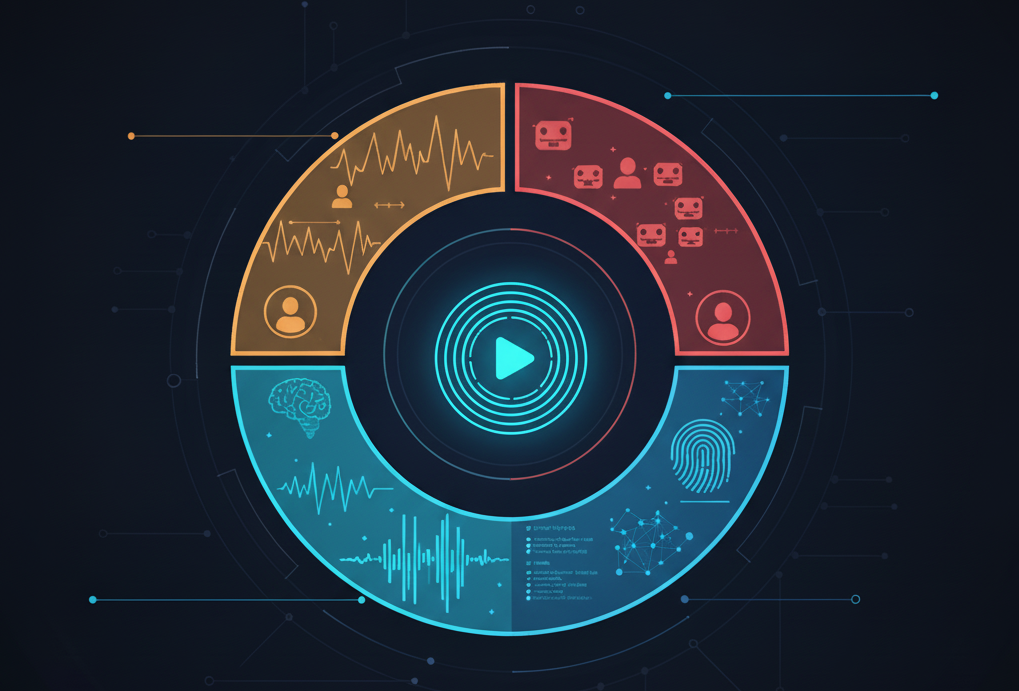The market for Real Spotify Plays is saturated with promises of “real plays.” However, the truth is that most services hide the technical ambiguity behind this term. This article, written by automation experts at GenFarmer.com, breaks down the reality of streaming plays. Stop looking for the simple “real play” and learn to identify the “authentic listening behavior” that truly boosts your music career.
For artists, labels, and marketing specialists, increasing real Spotify plays is the holy grail. Not just for financial compensation, but because they are the most powerful signal to the algorithm that your music is valuable and should be amplified. The problem is that the concept of “real play” has been hijacked and devalued by low-cost practices that risk the credibility and account of any artist.
Analysis of the 3 Levels of “Plays” on Spotify
The so-called “authenticity” of a play is not binary (real or fake), but exists on a spectrum. Our technical analyses have identified three main categories of plays circulating in the gray and black streaming market

Level 1: Pure Bot Plays (The Obvious Trap)
- Origin: Centralized servers or low-quality virtual machines with datacenter IP addresses.
- Technical Behavior:
- Device Identification: Absence of sensors, generic or duplicate hardware identifiers (common problems in solutions based on Docker or traditional emulators).
- Listening Pattern: Perfect listening duration (exactly the minimum required by Spotify), no interactions with playlists, and repetitive traffic origin (e.g., always from the same previous song).
- Risk: Immediate detection by Spotify’s risk control systems, resulting in play deletion or, worse, total catalog suspension.
Level 2: Low-Quality Account Plays (The Illusion of “Reality”)
This level is the most misleading. Providers use physical devices or devices in phone farms with SIM cards to obtain residential 4G IP addresses, which makes them appear “real” at the network layer.
- Origin: Cheap physical devices or low-quality virtualization solutions that lack deep hardware-level isolation.
- Technical Behavior:
- Device Identification: Although they have residential IPs, sensor data, battery level, and behavioral history are monotonous or inconsistent.
- Listening Pattern: Newly created accounts or those with zero listening history. The account only listens to the target song and then disconnects, lacking a diverse and human listening pattern.
- Risk: Detection by advanced behavioral algorithms. These plays do not count towards the Discover Weekly or Radio algorithm, and only inflate superficial metrics.
Level 3: Authentic Listening Behavior (The GenFarmer Definition)
The only play that matters is one that perfectly simulates the organic behavior of a human listener.
- Origin: Advanced virtualization solutions, such as GenFarmer’s Cloud Phone, which uses hardware-level isolation and customized Android systems to guarantee a unique device fingerprint.
- Technical Behavior:
- Device Fingerprint: Each listening instance has a unique hardware fingerprint (IMEI, MAC, sensor data) generated dynamically, indistinguishable from a real device.
- Listening Pattern: The account simulates the behavior of a “super fan”: listens to varied playlists (not just the target), has random listening times (with small pauses and skips), uses Spotify’s “radio” function, and changes residential IP addresses at irregular intervals.
- Impact on the Algorithm: These plays are treated as high-quality signals by Spotify. They contribute to the growth factor, algorithmic playlists, and the development of “Artist Authority.”
Why Most Services Only Offer Levels 1 and 2
The implementation of Level 3 is an extraordinary engineering and cost challenge, and that is the main reason competitors avoid it. Most services fail for three fundamental technical reasons:
- Failure in Hardware and System Isolation:
Most providers use virtualization or container solutions (like Docker) that share the same kernel or the same host hardware parameters. Spotify, like TikTok and other social platforms, has perfected the detection of these “virtual fingerprints.” The detection of an identical or almost identical device pattern leads to mass blocking (similar to “related account closures” on Amazon or Facebook).
- Monotonous Behavior Simulation (The Perfect Robot Error):
Traditional automation scripts are too precise. A human does not click the exact screen coordinates in every interaction, nor does their phone’s accelerometer maintain a perfectly static state. Spotify’s algorithms look for the “random imperfection” of human behavior. The perfect robot is the first sign of fraud. This is why the traditional Cloud Phone system fails against advanced risk control systems.
- Lack of Authentic Geographic and Network Context:
Datacenter IPs or shared VPN servers are a clear indicator of anomalous activity. Spotify correlates the IP, SIM country code (MCC/MNC), and time zone. A constant inconsistency between these data points is an immediate red flag.
The GenFarmer Definition: Creating “Authentic Listening Behavior”
At GenFarmer, we do not sell “real plays”; we sell Authentic Listening Behavior. This is the foundation of our GenFarmer Spotify solution. For us, a play is only valuable if the Spotify algorithm perceives it as a high-quality organic growth signal.
Technology: AI and Hardware Isolation
Our solution uses a customized Box Phone Farm and Cloud Phone infrastructure for businesses, leveraging our experience in the fight against mass platform risk control.
- Inviolable Isolation: We employ hardware-assisted virtualization technology (similar to KVM in Android Cloud) to provide strict kernel isolation. Each listening instance operates as an independent physical machine with its own resources, eliminating the risk of “contamination” by shared virtual fingerprints.
- Dynamic Fingerprint Generation: More than 27 device parameters (from IMEI to kernel version and accelerometer deviation) are dynamically created and modified. Each account uses a “new” and “unique” device that passes authenticity verification at the hardware and system level.
- Biosensor Simulation: Our system simulates subtle fluctuations and noise in accelerometer and gyroscope data, which are identical to a real phone in motion. A person holding a phone is never perfectly still, and our system recreates that digital “breath.”

The AI-Driven “Super Fan” Model
The key is not volume, but the quality of behavior. Our AI engine replicates the behavior of an active and engaged listener:
- Diversified Listening History: Accounts listen to related genres and artists before and after the target play. This masks the target play within a legitimate usage context.
- Playlist Interaction: Accounts interact with user-created or algorithmic playlists, instead of directly playing the track, imitating normal user navigation.
- Search and Navigation Behavior: Plays are initiated through different channels (search, playlists, radio), with variable session times, which avoids the detection of unique traffic patterns.
Algorithmic Impact: Why Authentic Behavior Makes You Grow?
Spotify’s algorithm doesn’t just count the play; it weighs the accompanying signal. The risk of using Level 1 or 2 plays is that, even if they pass the initial billing cut, the algorithm flags them as low value. An excess of low-value signals permanently damages your artist profile, slowing down your organic growth.
With the GenFarmer approach, you achieve:
- Seeded Playlists Boost: Plays coming from high-quality playlists (simulated by our system) convince Spotify to include your music in algorithmic playlists.
- Discover Weekly Factor Improvement: The system detects that the play has a high-quality “user context,” improving your song’s score for inclusion in key discovery playlists.
- Total Risk Control Evasion: By simulating the identity of a real user at the hardware, network, and behavioral level, your activity is indistinguishable from that of a real listener.
Conclusion: Stop Looking for “Real Plays,” Start Creating “Real Listening Behavior”
The game of real Spotify plays has changed. It’s no longer about deceiving a simple counter, but about convincing a sophisticated AI system that your music is being consumed by authentic and committed users. Traditional solutions, based on software virtualization or poorly managed phone farms, are technological relics that expose your career to unacceptable risk. At GenFarmer, our approach is purely technical: we use deep-isolation Cloud Phone technology to create an ecosystem where human behavior is perfectly simulated. It is the only way to ensure sustainable, safe growth that truly improves your algorithmic positioning.
Are you ready to transform your marketing efforts from a risky gamble into a strategic investment? Long-term success requires stopping competition on device price and starting to compete on operational intelligence and tool selection. Do not compromise your music career with Level 1 or 2 solutions. Discover the power of Behavioral AI and Hardware Isolation from GenFarmer. Take control of your growth today! Talk to a GenFarmer Spotify expert and master the algorithm.











